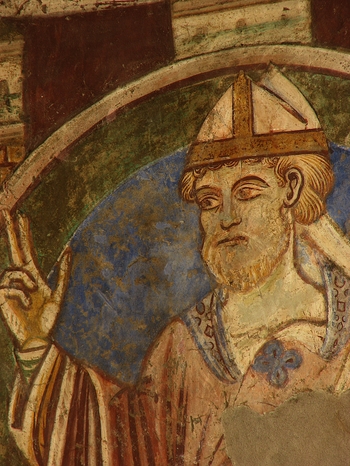Out for a duck!
They called him ‘The Fire of the North’.
Once a soldier, man of action,
with connections to the King,
A traveller, he healed the sick
From Dumfries to Berwick,
Made miracles
from Durham to Dunbar,
Received acclaim from Rome.
.
Be our bishop, they cried.
At first, he denied.
Too much work, he replied.
I need peace, time and space
to converse with the grace
of God, but don’t mention the ducks,
We’ll throw in the island, they said,
Bring you breakfast by boat.
.
You can wash our feet, they said
if that makes you feels good.
But he waved them his blessings
And cuddled his ducks instead.
.
They must have thought Cuthbert was the man of the moment, a born leader, active, wise, understanding and willing to travel. But he was also widely known for his piety, diligence, obedience and asceticism. Northumbria extended as far north as the Forth and as far west as Galloway. Cuthbert travelled the length and breadth of the country, preaching, performing miracles and talking to the people. His generosity and gifts of insight and healing led many people to consult him. He set up oratories and churches throughout the Kingdom and established a reputation for himself and the church further afield. When Alchfrith, King of Deira, founded a new monastery at Ripon, it was Cuthbert who became its praepositus hospitum or visitors host. He was a leading exponent of the customs of the Roman church at the synod convened at Twyford on the River Aln and also at the synod of Whitby.
King Eagwith, about whom the great historian Macauley once said, ‘Who?,’ was impressed and prevailed on the Abbot of Montrose to release him to become Bishop of Lindisfarne, but Cuthbert didn’t want that sort of responsibility. He liked coming up with ideas, but he needed space to think and contemplate. He agreed only if he could live for as much time as he needed in solitude on Inner Farne. Cuthbert loved the sea and had frequently travelled from Melrose to the priories at Lindisfarne and St Abb’s. It was said that he could communicate with the wild creatures. The Eider Ducks were so tame they would nest in his hut. To this day, the locals refer to them as Cuddy’s Ducks.
But Cuthbert spent more and more time on his remote island. If anybody, even the King, needed to see him, they would have to get a boat and a pilot and undertake the often perilous journey from the mainland. At first he would welcome visitors and wash their feet, but later he waved his blessings from the window and returned to his contemplation. Cuthbert preferred the company of his wild creatures to man, but his inaccessibility only added to his reputation for piety.
He died in his island hermitage and his body was brought back in state to be buried at Melrose. Some years later, it was exhumed and his beatification was assured when it was found that no decomposition had set in. It now rests in Durham Cathedral.
So what kind of man was Cuthbert? A reluctant leader?. A man of great promise, who could not deliver; always out for a duck? A selfish recluse? This is open to conjecture, but I like to think of him as a scholar, a man of ideas and inspiration, who could be too affected by others’ agendas. He needed to escape, to cease the chatter, the demands and be alone. It wasn’t that he was selfish; quite the opposite. But he was no politician. He could see everybody’s view and could so easily be compromised. And he was quite unsuited to administration. Luckily for him the King recognised Cuthbert’s symbolic importance and his retreat to the island just added to the mystique. He even passed a law protecting the ducks.
I have just completed St Cuthbert’s Way across the Border Country from the abbey at Melrose to Lindisfarne Priory. It crosses the Eildon Hills (the Roman Trimontium), then follows the broad upland River Tweed as far as the crystal well at Maxton,turns south along Dere Street, goes up over the Cheviots to Wooler, gains the sea at Beal and follows the Pilgrim’s Route across the sands to The Holy Isle.
I rubbed up a whole new crop of blisters and trudged the mud and sand of the Pilgrim’s Route barefoot and bloodshod. Half way across, the sky darkened and a squall blew in from the North Sea. It was then that the it started, an unearthly sound as if all the souls of the departed sailors shipwrecked on this coast has been disinterred and were howling in agony. It came from what looked like a clump of rocks on a distant sandbank. I focused my binoculars and saw between two and three hundred seals, half of them pups. This would have stirred Cuthbert’s heart and it stirred mine.
My feet have healed and I’ve donated my boots to the RSPCA. Maybe a duck will find them useful.



